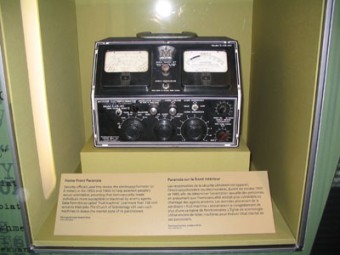When the Canadian Government Used “Gay Detectors” to Try to Get Rid of Homosexual Government Employees
 We are all familiar with the colloquialism “gaydar” which refers to a person’s intuitive, and often wildly inaccurate, ability to assess the sexual orientation of another person. In the 1960s, the Royal Canadian Mounted Police (RCMP) attempted to use a slightly more scientific, though equally flawed, approach- a machine to detect if a person was gay or not. This was in an attempt to eliminate homosexuals from the Canadian military, police and civil service. The specific machine, dubbed the “Fruit Machine”, was invented by Dr. Robert Wake, a Carelton University Psychology professor.
We are all familiar with the colloquialism “gaydar” which refers to a person’s intuitive, and often wildly inaccurate, ability to assess the sexual orientation of another person. In the 1960s, the Royal Canadian Mounted Police (RCMP) attempted to use a slightly more scientific, though equally flawed, approach- a machine to detect if a person was gay or not. This was in an attempt to eliminate homosexuals from the Canadian military, police and civil service. The specific machine, dubbed the “Fruit Machine”, was invented by Dr. Robert Wake, a Carelton University Psychology professor.
Taking the lead from the United States’ McCarthyism, the Canadian government considered all homosexual public servants to be a threat to national security for various absurd reasons. In order to deal with the “security threats” posed by gay people, a special team in the RCMP was formed. Section A-3’s sole mission was to identify and dismiss from service every homosexual working for the Canadian government. Identified homosexuals were immediately fired or forced to resign.
Initial efforts included following people around and undercover work at various clubs, but this proved to be extremely costly and somewhat inefficient. Thus, Section A-3 decided they needed a new plan, a way to screen every employee directly. This new plan was the “Fruit Machine”.
The Fruit Machine primarily used the “pupil area response test” as an indicator of a person’s sexual orientation, as well as perspiration levels and pulse rate. While undergoing the test, the subject would sit in a dentist-style chair. They’d then be shown various images, some completely mundane, while others depicted naked or semi-naked photos of women and men. If the subject’s pupils dilated when being shown erotic photos of people of the same gender, s/he was assumed to be homosexual.
Besides the “science” behind the machine being completely flawed, there were other problems as well. For instance, each photograph changed the amount of light hitting the person’s eyes. If the difference from one slide to another was large enough, this obviously would change the subject’s pupil dilation, but was not accounted for in the results.
The Fruit Machine was not a stand alone test, but many of the other methods used were just as ridiculous. For instance, another test run by the RCMP included monitoring subjects’ physiological responses to specific words such as queer, gay, drag and even bar.
As you might expect, once word got out that the Fruit Machine test was attempting to determine if you were gay or not, rather than a stress testing machine as people were initially told, getting people to take the test became nearly impossible. That, along with numerous mechanical failures with the machine itself, soon got funding for that particular part of the program cut off and the RCMP’s dream of having a gaydar to screen all Public Employees with was put on hold, though that didn’t stop them from continuing their work trying to root out “dangerous” homosexuals from the Canadian payroll.
Not to be deterred, the RCMP eventually started using a new type of machine, this one, a type of plethysmograph that measured blood flow to genitals while the subject is shown various images. While not nearly as scientifically flawed as the Fruit Machine, this one also, as you might expect, doesn’t give terribly accurate results on the whole and eventually the program for trying to root out homosexuals was abandoned by the Canadian government, but not before at least 400 people lost their jobs after being accused of being gay (with some estimates being significantly higher).
If you liked this article, you might also enjoy our new popular podcast, The BrainFood Show (iTunes, Spotify, Google Play Music, Feed), as well as:
- How “Gay” Came to Mean “Homosexual”
- John Lennon Once Nearly Beat a Man to Death for Suggesting Lennon Might Be Gay
- When the American Government Intentionally Poisoned “Undesirable” American Citizens, Killing Over 10,000
- The Only Major League Baseball Player to Openly Admit He was Gay During His Career Also Popularized the High Five
- How to Read an EKG
Bonus Facts:
- Despite that penile plethsymograph and the vaginal photoplethysmograph are somewhat flawed in detecting someone’s sexual orientation, it is still used to this day in nations like Canada and the United States to try to measure sexual arousal in certain people, though now being used primarily on pedophiles, ephebophiles, and rapists. Some have even pushed for its use in trials, but to date such evidence is not generally admissible in court in either the U.S. or Canada owing to the highly flawed nature of the results of the test. Despite this, there are exceptions, such as that courts do use the results of these tests to monitor convicted offenders to help determine things like if they are likely to become repeat offenders if let out of prison.
- In Czechoslovakia, such a test was recently used to try to determine if refugees from Iran were actually gay or not, to see if they should be given asylum. (The penalty for being gay in Iran is death and the two in question claimed if they were sent back to Iran, they’d be killed as the police were looking for them due to their homosexuality.)
- Funny enough, according to a 1996 study at the University of Georgia, using the somewhat flawed penile plethsymograph test (so take these results with a grain of salt), they found that homophobic men were more likely to be sexually aroused by depictions of gay sex than non-homophobic men.
 Canada is not the only country ashamed to have a Fruit Machine as part of their history. The American version of the Fruit Machine (pictured right) is currently on display at the new war museum in Ottawa, Canada. The Canadian Fruit Machine, which was much more elaborate than its American counterpart, has been lost and thought to have been destroyed when that part of the program was shut down.
Canada is not the only country ashamed to have a Fruit Machine as part of their history. The American version of the Fruit Machine (pictured right) is currently on display at the new war museum in Ottawa, Canada. The Canadian Fruit Machine, which was much more elaborate than its American counterpart, has been lost and thought to have been destroyed when that part of the program was shut down.- Delta airlines once argued in a plane crash litigation case that they should pay less for gay passenger deaths owing to the fact that the gay person may have had AIDS, so at that time would have died soon anyways… Delta Airlines later apologized for making that argument.
- In 1952, the Unites States Congress enacted a law banning lesbians and gay foreigners from entering the country. The law was on the books until it was repealed in 1990.
- A “beard” is someone of the opposite sex who knowingly dates a closeted lesbian or gay man to provide that person with a heterosexual “disguise,” usually for family or career purposes.
| Share the Knowledge! |
|





My gaydar tells me you’re fruitier than a box of watermelons
I think it should be noted that particularly in the UK, the term “fruit machine” generally indicates the reeled gambling device also known as a slot machine
‘Gay’ used to mean ‘merry’ or ‘in a happy mood.’ That is the meaning that most people would have cited in 1970. The sexual meaning was known to most educated speakers but secondary. By analogy, if you said someone was ‘queer’ you meant that he was odd or unusual in a puzzling way, not homosexual. The term “a queer” sprang up to serve as slang for a gay person. Over the last 50 years we have become obsessed with sex as a society and can’t help but notice the possible sexual meaning of anything. After 1970 it was impossible to pronounce ‘Uranus’ correctly without guffaws but before that you could.
I’m reminded of a different experiment where pictures of, among other things, of a naked woman and a flower being flashed across a screen very quickly. Most men had a reaction to the naked woman. However, one of them had no reaction to the naked woman, but he did to the flower. It turned out he was a newly married man, who saw enough female nudity at home, but he was also a florist, and every time the flower flashed into view, he tried to identify it.
Bullshit